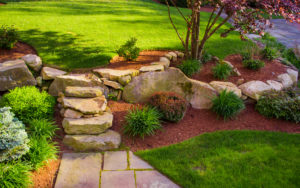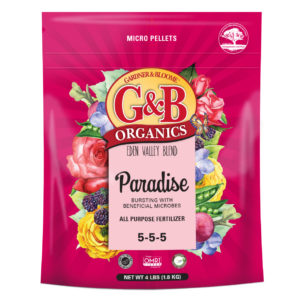
Landscaping Fabric for Planting Beds
Posted by Grange Co-op on 19th Jul 2021
What Is Landscaping Fabric?
Landscaping fabric, also known as landscape fabric, is a textile material used to prevent the growth of weeds in your planting beds. The material inhibits sunlight and covers sections of the plants you wish to protect, while still allowing moisture and water to the soil. Landscape fabric is a great way to protect your planting beds from unwanted weeds, saving you time by reducing maintenance in the long run.
Cost and Composition of Landscaping Fabric
Landscaping fabric is made with woven fibers or a perforated material to allow water and moisture to pass through. Certain brands provide UV protection to increase the durability of the product. Often used under rock and gravel landscaping, it can be a helpful and wise choice in the landscape design of a yard. Landscape fabric can most often be purchased in rolls that are at least 3 feet wide and 50 feet or more in length.
The cost of landscaping fabric can vary depending on thickness and brand. The thicker the fabric, the higher the price. Landscape pins are sold separately and are important to secure the fabric. While they do add to the overall cost of your project, it is extremely important to include landscape pins for the longevity and accuracy of your fabric.
Keep in mind that almost all landscaping fabric is designed to be covered with some type of mulch. This can be recycled rubber, gravel, wood chips, etc.
Key Advantages of Landscaping Fabric
Using landscape fabric is excellent and offers advantages to help keep your planting beds healthy. The good news is that the landscape fabric will work, but not forever. It lowers the number of weeds but long term can compromise soil health.

Here are some of the benefits of using landscape fabric for gardening purposes.
- Having a landscape fabric allows you to significantly reduce the maintenance of gardening, such as weeding.
- It prevents inorganic mulches from soaking underneath the soil.
- Reduces the need to use herbicides for weed control.
- Lowers evaporation which is helpful in retaining soil moisture.
- Provides some level of soil erosion control on slopes vulnerable to washout because of heavy rains.
Notable Disadvantages of Landscaping Fabric
We recommend using landscaping fabric on plant beds that consist of perennials, such as shrubs and greenery, rather than in vegetable gardens or annual flower beds. We've outlined the reasoning why many gardening experts discourage the use of landscaping fabric for uses such as this:
1. Compaction of the Soil
In order for a garden to be truly healthy, the soil needs to be loosened from time to time. Loose soil allows water, nutrients, and even air to get down in the soil and encourage plant growth. Loose, crumbly soil allows plants to spread their roots and thrive without too much difficulty.
2. Contains Dangerous Chemicals
Landscaping fabric comprises petroleum and various other dangerous chemicals. Most gardening professions recommend gardeners to avoid using petroleum products or products with chemicals around edible plants and vegetables.

3. Prevents Soil Replenishment
Natural organic mulch, such as pine needles or fallen leaves, cannot replenish nutrients in the soil since the fabric works as a barrier. Without fabric, this kind of organic material would biodegrade naturally and ultimately blend with the soil. Keeping this in mind, it's always important to amend your soil annually to replenish nutrients that would generally come from decaying plant debris.
4. Makes Pulling Weeds a Nightmare
Some garden beds have existing weeds that remain alive even when landscape fabric covers them. These extremely stubborn weeds that do manage to get through the fabric can quite horribly entangle with the fabric itself. Because of this, it makes removing the weeds extremely difficult, and at times, pulling the weed even results in ripping the landscaping fabric.
5. Makes Re-seeding Impossible
One of the best things about vegetable gardening is seeing which vegetables have re-seeded themselves year after year. However, when you install landscape fabric, it's almost impossible for vegetables to re-seed themselves.
Installing Landscape Barrier
Installing techniques depend on the location of the landscape fabric. Fabric should be installed on even ground and healthy soil. Landscaping fabric can be purchased in many different roll sizes and widths. Carefully choose a length that maximizes the fabric with as few cuts as possible.
If cutting the fabric is necessary, either in order to turn a corner or create an angle, it's important to overlap the fabric at the seams and secure it with landscape pins. This will help create a solid barrier, making it difficult for weeds to grow through the barrier.
Digging and Planting

Once the landscape barrier is installed, you won't be able to dig the soil, so make sure you do all your digging before you spread the fabric. We recommend breaking up the soil at the base of the bed using a garden fork. Rake the soil smooth to break up any large clumps, and amend with an all-purpose organic soil such as Rogue Premium Blend Organic Potting Soil.
Once this is complete, install the fabric above and choose where you would like to place your plants. Cut the hole for the plant in a large "X", folding the fabric in on itself to create an opening to dig the planting hole. Make sure to consider spacing for healthy plant growth and maturity, as well as considering sunlight and shade of the location as well. Once this is done, place your chosen plants in each of the holes, backfilling and fertilizing with granular fertilizer, such as G&B Paradise Fertilizer, or a liquid fertilizer like G&B All-Purpose Fertilizer.
Mulching to Cover & Protect Fabric
Next, cover your fabric to protect it from direct sunlight and harsh weather conditions, preserving the life of your fabric for many years to come. Depending on your desired look, you can do this by filling the bed with a woody soil amendment, such as G&B Soil Building Conditioner, or you can fill it with a manure/compost mixture like G&B Harvest Supreme. If you're interested in covering your fabric with bark, visit our blog post, Mulching for a Healthy Soil and Ecosystem for more information on what types of materials are best for mulching plant beds.
Last Few Words
Supplied with the knowledge of how best to harness the benefits of landscape fabric, you can make an informed decision when incorporating it into your landscaping techniques. For more information on gardening, visit us in-store to speak with a Grange Gardening Expert, or read additional gardening-focused blogs on our website.
